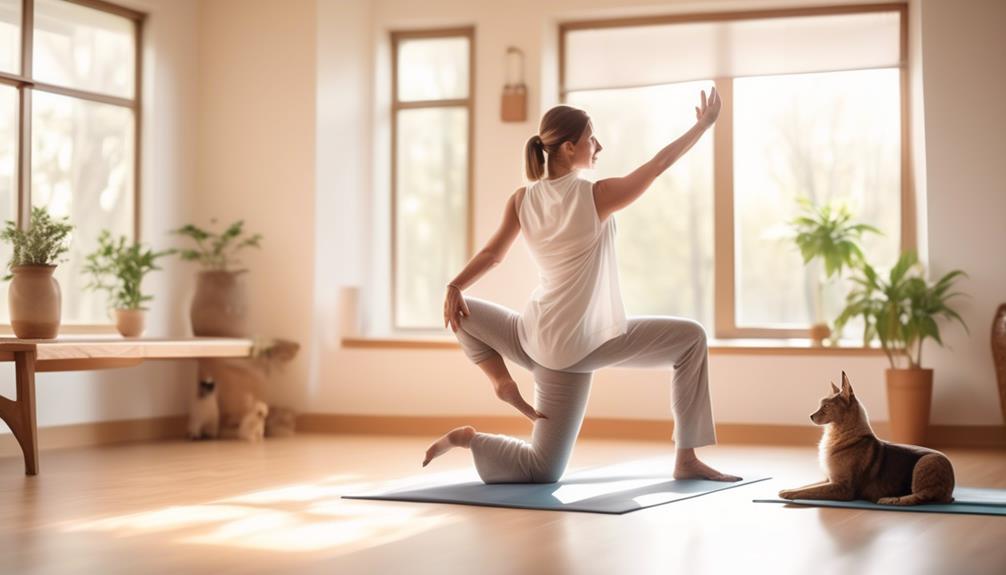When Pet Yoga Helps in Recovery Post-Surgery

Pet yoga has numerous benefits for individuals in the recovery process. Firstly, it helps to reduce stress, which is often heightened during this time. The combination of yoga and the presence of a beloved pet creates a calming environment, allowing individuals to relax and let go of their worries. Secondly, pet yoga promotes physical healing. The gentle movements and stretches involved in yoga can help to improve flexibility, strength, and circulation, which are all important factors in the recovery process. Finally, pet yoga enhances emotional well-being. The bond between a person and their pet is known to have positive effects on mental health, including reducing feelings of loneliness and depression. The presence of a pet during yoga can provide comfort and emotional support, making the recovery journey a little bit easier.
Key Takeaways
- Pet yoga can be beneficial for recovery post-surgery by reducing stress and promoting relaxation.
- Engaging in pet yoga can improve physical healing, flexibility, and overall well-being.
- Bonding with pets through pet yoga can provide emotional support and alleviate stress and anxiety.
- It is important to start slow, consult with a healthcare provider, and ensure the safety and comfort of both the individual and the pet during the practice of pet yoga.
The Benefits of Pet Yoga for Post-Surgical Recovery
Pet yoga can offer numerous benefits for individuals recovering from surgery, providing them with a unique and therapeutic way to regain strength and enhance their overall well-being.
One of the key benefits of pet yoga in post-surgical recovery is its effectiveness in pain management. The gentle stretching and movement involved in pet yoga can help alleviate pain by promoting blood circulation, releasing endorphins, and reducing muscle tension. By incorporating pet yoga into their physical therapy routine, patients can experience improved pain control and a faster recovery process.
Pet yoga can also help individuals recovering from surgery to regain strength and mobility. The poses and movements involved in pet yoga engage different muscle groups, improving flexibility, balance, and coordination. This can be particularly beneficial for patients who've undergone surgeries that may have caused muscle weakness or limited range of motion. By practicing pet yoga, patients can gradually rebuild their strength and regain their physical abilities.
Furthermore, pet yoga provides emotional and mental support during the recovery process. The presence of a beloved pet can bring comfort, reduce anxiety, and increase feelings of well-being. Pet yoga offers a unique opportunity for patients to bond with their pets while engaging in a therapeutic activity, promoting a sense of companionship and connection.
Incorporating pet yoga into physical therapy sessions can be a valuable addition to a post-surgical recovery plan. It not only helps manage pain, but also enhances strength, mobility, and emotional well-being. By embracing the healing power of pet yoga, individuals recovering from surgery can experience a holistic approach to their recovery and find comfort in the presence of their furry friends.
Reducing Stress and Anxiety Through Pet Yoga

Reducing stress and anxiety through pet yoga can be incredibly beneficial for individuals recovering from surgery.
Calming breathing exercises practiced during pet yoga sessions help to relax the mind and body, promoting a sense of tranquility.
Bonding with furry friends during these sessions can also provide emotional support and companionship, further reducing stress and anxiety.
Calming Breathing Exercises
Engage in deep and conscious breaths to cultivate a sense of inner calm and alleviate stress and anxiety during your pet yoga practice. Breathing techniques play a crucial role in reducing stress and anxiety, allowing you to fully embrace the healing power of pet yoga. Here are five calming breathing exercises to enhance your practice:
- Deep Belly Breathing: Inhale deeply through your nose, allowing your belly to expand. Exhale slowly through your mouth, releasing any tension or worries.
- 4-7-8 Breath**: Inhale for a count of 4, hold for 7, and exhale for 8. This technique helps slow down your heart rate and induce relaxation.
- Alternate Nostril Breathing: Close your right nostril with your thumb, inhale through your left nostril. Close your left nostril with your ring finger, exhale through your right nostril. Repeat, alternating nostrils.
- Box Breathing: Inhale for 4 counts, hold for 4, exhale for 4, and hold for 4 again. This technique helps regulate breathing and calm the mind.
- Guided Visualization**: Close your eyes and imagine a peaceful scene with your pet. Breathe deeply and imagine the stress melting away as you visualize yourself in a state of tranquility.
Bonding With Furry Friends
As you deepen your connection with your furry friend through pet yoga, you'll discover a powerful tool for reducing stress and anxiety. Bonding activities, such as pet therapy, have been proven to be incredibly beneficial for individuals seeking stress relief and emotional support. Engaging in pet yoga not only allows you to spend quality time with your beloved pet but also helps to cultivate a stronger bond between you and your furry companion.
Pet therapy, also known as animal-assisted therapy, involves the use of animals to enhance a person's physical, emotional, and social well-being. By incorporating pet therapy into your yoga routine, you not only gain the physical benefits of the practice but also the added emotional support and comfort provided by your furry friend. The presence of animals has been shown to reduce feelings of stress, anxiety, and loneliness, while also promoting a sense of calm and relaxation.
Through pet yoga, you and your furry friend can engage in various bonding activities, such as gentle stretches, massages, and partner poses. These activities not only strengthen your bond but also provide an opportunity for mutual relaxation and stress reduction. The physical touch and connection created during pet yoga can release endorphins, which are natural mood boosters that help alleviate stress and anxiety.
Incorporating your pet into your yoga practice can also enhance mindfulness and presence. As you focus on your breath, movement, and connection with your furry friend, you become fully present in the moment, letting go of worries and distractions. This heightened state of mindfulness can lead to a greater sense of peace, tranquility, and overall well-being.
Promoting Relaxation and Healing
Pet yoga offers a unique and effective method for promoting relaxation and healing, helping individuals reduce stress and anxiety while fostering a stronger bond with their furry companions. By incorporating pets into yoga practice, people can experience numerous benefits that aid in their recovery post-surgery. Here are some ways pet yoga can promote relaxation and healing:
- Reducing pain: The gentle movements and stretches in pet yoga help to alleviate pain and discomfort, allowing the body to heal more effectively.
- Improving flexibility: Engaging in pet yoga can enhance flexibility, making it easier for individuals to regain their range of motion after surgery.
- Boosting mood: Spending quality time with pets during yoga sessions releases endorphins, which can elevate mood and reduce anxiety levels.
- Enhancing mindfulness: The presence of pets during yoga encourages individuals to be present in the moment, enhancing mindfulness and relaxation.
- Strengthening the bond: Practicing pet yoga together creates a deeper connection between humans and their furry friends, providing a sense of comfort and companionship during the recovery process.
Pet yoga not only supports physical healing but also promotes emotional well-being, making it an invaluable tool for post-surgery recovery.
Promoting Physical Healing With Pet Yoga

Promoting physical healing through pet yoga offers a range of benefits for individuals recovering from surgery.
The practice not only helps to improve flexibility and strength, but also stimulates blood circulation and promotes faster healing.
In addition, the connection formed between humans and their pets during pet yoga can provide emotional support and motivation, enhancing the overall healing process.
Benefits of Pet Yoga
With the gentle movements and soothing presence of a furry companion, individuals can find solace and accelerate their physical healing through the practice of pet yoga.
Pet yoga not only promotes mindfulness but also improves flexibility, allowing individuals to regain strength and mobility after surgery.
Here are some of the key benefits of incorporating pet yoga into post-surgery recovery:
- Reduces stress and anxiety: The calming presence of a pet during yoga practice helps to lower stress levels and promotes a sense of relaxation, which is crucial for the healing process.
- Increases blood circulation: The gentle movements and stretches in pet yoga help to improve blood flow, delivering vital nutrients and oxygen to the healing tissues.
- Enhances range of motion: Regular practice of pet yoga helps to improve flexibility and joint mobility, allowing individuals to regain their full range of motion more quickly.
- Builds core strength: Pet yoga engages the core muscles, helping to strengthen the body's foundation and support overall physical recovery.
- Boosts overall well-being: Pet yoga not only aids in physical healing but also provides emotional support, fostering a sense of companionship and boosting overall well-being.
Healing Through Pet Connection
During the post-surgery recovery process, individuals can experience accelerated physical healing through the profound connection and therapeutic benefits of practicing pet yoga.
Pet yoga is a unique form of exercise that combines traditional yoga poses with the presence of pets, such as cats or dogs. This practice promotes physical healing by engaging the body in gentle movements and stretches, while also offering emotional support and companionship through the presence of a beloved pet.
The healing benefits of pet yoga are manifold. First, the gentle movements and stretches help to improve circulation, flexibility, and range of motion, which can aid in the recovery process. Additionally, the presence of a pet creates a therapeutic connection that can reduce stress, anxiety, and pain, ultimately promoting a faster and more effective healing process.
Pet yoga offers a holistic approach to recovery, addressing both the physical and emotional aspects of healing, and can be a valuable tool in supporting individuals during their post-surgery journey.
Enhancing Emotional Well-being Through Pet Yoga

Incorporating pet yoga into one's post-surgery recovery can greatly enhance emotional well-being. Pet therapy benefits and mental health benefits are well-documented, and when combined with the mindfulness and physical benefits of yoga, it creates a powerful practice that promotes healing and emotional well-being.
Here are some ways in which pet yoga can enhance emotional well-being during post-surgery recovery:
- Companionship: Having a furry friend by your side during yoga practice can provide a sense of comfort and companionship, reducing feelings of loneliness and isolation.
- Stress reduction: The presence of a beloved pet can help alleviate stress and anxiety, allowing you to relax and fully engage in your yoga practice.
- Mood enhancement: Interacting with animals releases endorphins, the feel-good hormones that boost mood and promote a sense of happiness and well-being.
- Emotional support: Pets have a unique ability to sense and respond to our emotions. During pet yoga, they can provide emotional support, offering comfort and reassurance.
- Mindfulness practice: Pet yoga encourages you to be fully present in the moment, focusing on the movements and the bond with your pet. This mindfulness practice can help reduce rumination and promote a positive mindset.
Building a Stronger Bond With Your Pet During Recovery

To foster a deeper connection with your pet while recovering from surgery, focus on engaging in activities that promote bonding and mutual understanding. Building a stronger bond with your pet during the recovery process can be beneficial for both of you. Not only can it provide emotional support and companionship, but it can also aid in the healing process. Spending quality time together can strengthen the connection you have with your pet and deepen your relationship.
One way to build this bond is through gentle physical contact. Petting, grooming, and cuddling your pet can create a sense of comfort and reassurance for both of you. This physical touch releases oxytocin, a hormone associated with bonding and stress reduction.
Engaging in interactive playtime is another effective method. Playing games such as fetch or hide-and-seek can be not only physically stimulating but also mentally engaging for your pet. This shared activity can create a sense of joy and strengthen the bond between you.
Additionally, involving your pet in your daily routine can help deepen your connection. Taking walks together, allowing your pet to accompany you on errands, or simply having them nearby while you do chores can strengthen the bond and provide a sense of companionship.
Tips for Getting Started With Pet Yoga After Surgery

If you're recovering from surgery and looking to incorporate pet yoga into your healing process, here are some helpful tips to get started:
- Start Slow: Begin with gentle stretching and basic poses to allow your body to adjust gradually. Remember to listen to your body and not push yourself too hard.
- Choose a Quiet Space: Find a quiet and peaceful area in your home where you and your pet can practice without distractions. This will help create a calm and relaxing environment for both of you.
- Use Props: Incorporate props such as blankets, bolsters, or blocks to provide support and make the practice more accessible. This can be especially helpful if you have limited mobility due to surgery.
- Involve Your Pet: Encourage your pet to join you in the practice by using treats or toys as a form of motivation. You can also incorporate their natural movements, such as stretching and rolling, into your routine.
- Stay Consistent: Consistency is key when exploring alternative therapies like pet yoga. Aim for regular practice sessions, even if they're short, to reap the maximum benefits and strengthen your bond with your pet.
Remember to consult with your healthcare provider before starting any new exercise routine, especially if you're recovering from surgery. They can provide guidance and ensure that pet yoga is a safe and suitable option for your specific needs.
Enjoy the journey of incorporating pets into your exercise routine and embrace the healing power of this unique practice.
Exploring Different Pet Yoga Practices for Recovery

As you continue your post-surgery recovery journey with pet yoga, it's important to explore the various practices that can aid in your healing process. Incorporating pets in your yoga practice can bring added benefits to your recovery, both physically and emotionally. Different pet therapy techniques can be used to enhance your yoga sessions and promote a sense of calm and well-being.
One way to incorporate pets in your yoga practice is through "Doga," which involves performing yoga poses with your furry companion. This practice not only allows you to bond with your pet but also provides gentle stretching and relaxation exercises for both of you. Another option is "Cat Yoga," where you can practice yoga while your cat freely roams around the room, adding a playful and calming element to your routine. Additionally, "Goat Yoga" has gained popularity in recent years, offering a unique experience of practicing yoga outdoors while interacting with friendly and curious goats.
To better understand the different pet therapy practices and their benefits, here is a table showcasing three popular options:
| Practice | Description | Benefits |
|---|---|---|
| Doga | Performing yoga poses with your pet, promoting bonding and relaxation for both of you. | Improved flexibility, reduced stress, increased connection with your pet. |
| Cat Yoga | Practicing yoga while your cat freely moves around, creating a playful atmosphere. | Stress reduction, increased focus, enhanced mindfulness, and interaction with cats. |
| Goat Yoga | Practicing yoga in the presence of friendly goats, adding a joyful and unique element. | Increased sense of joy, relaxation, and connection with nature and animals. |
Exploring these different pet therapy practices can help you find the one that resonates with you and supports your post-surgery recovery journey. Remember to listen to your body and consult with your healthcare provider before starting any new exercise regimen.
Frequently Asked Questions
Can Pet Yoga Be Practiced by Anyone, Regardless of Their Age or Physical Condition?
Can pet yoga be practiced by anyone, regardless of age or physical condition? Yes, pet yoga can benefit older adults by promoting flexibility and relaxation. It can also help individuals with physical limitations improve strength and mobility.
What Are Some Safety Precautions to Keep in Mind When Practicing Pet Yoga After Surgery?
Safety precautions are important when practicing pet yoga post-surgery. It's crucial to consult with a healthcare professional before starting. Take it slow and listen to your body. The benefits of pet yoga in recovery include reduced stress and improved flexibility.
Is It Recommended to Consult With a Healthcare Professional Before Starting Pet Yoga as Part of Post-Surgical Recovery?
Consulting healthcare professionals is highly recommended before starting pet yoga for post-surgical recovery. They can provide personalized guidance on how pet yoga can impact recovery, ensuring a safe and effective healing process.
How Long Should Each Pet Yoga Session Be for Optimal Recovery Benefits?
Each pet yoga session should be around 15-20 minutes for optimal recovery benefits. These sessions can help improve flexibility and circulation, reduce stress and pain, and promote overall well-being during the recovery process.
Are There Any Specific Poses or Techniques in Pet Yoga That Should Be Avoided During Post-Surgical Recovery?
During post-surgical recovery, it is important to avoid certain pet yoga poses that may strain healing areas. However, pet yoga can aid in the healing process by promoting relaxation, gentle stretching, and improved circulation.









